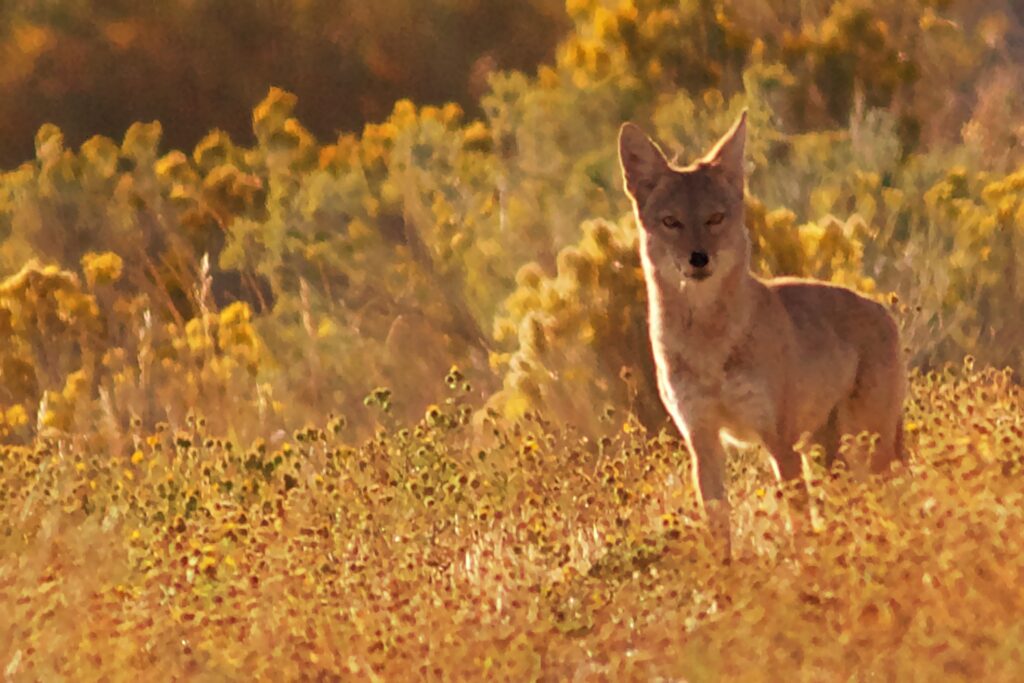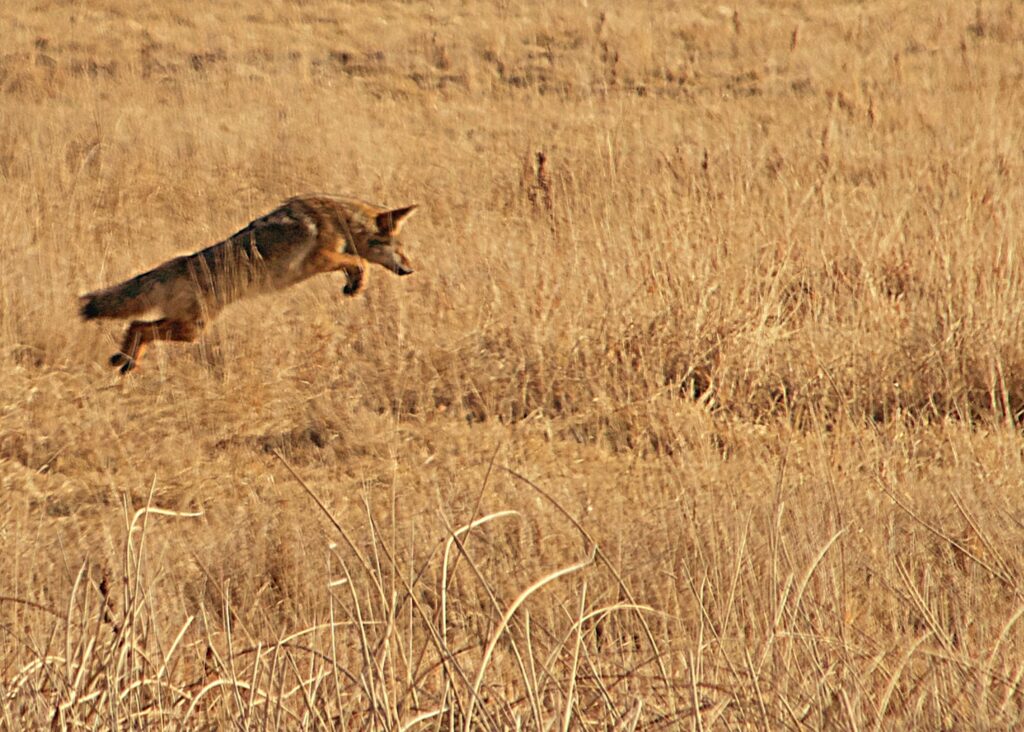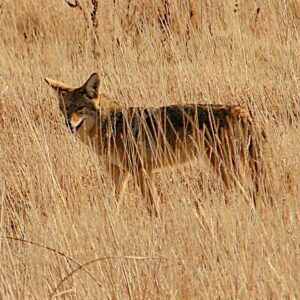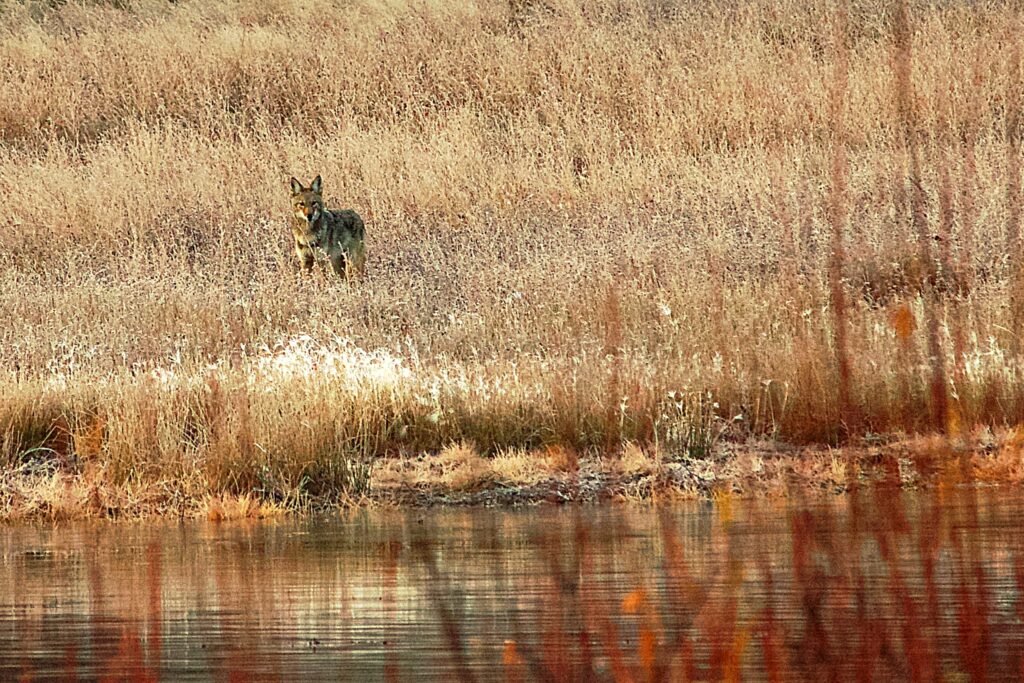So one evening a couple of weeks ago I was hiking along the Pinyon Trail and heard sounds like this coming from below me…
This beautiful, haunting sound is of course the coyote.

If you live in the Carson Valley, chances are good you have seen one or heard one, as coyotes flourish throughout the entire state of Nevada including urban areas. Even Las Vegas and Reno have resident coyotes!
Coyotes average about 24 inches tall at the shoulder and, including the tail are approximately four feet in length. Coyotes in the desert average about 20 pounds, while those found in mountainous areas average twice that. Females are slightly smaller than males. Coyotes can run at speeds of 25 to 30 miles per hour up to a sprinting burst of 40 miles per hour. By comparison, the fastest human, Usain Bolt, has a top sprint speed of just 28 mph! They can travel well over 100 miles in a single night.
The reason coyotes are so common is that they can be found in almost any type of habitat where they can find food and a place to hide. They are opportunistic feeders, and in urban areas forage at landfills and raid garbage cans . In most areas of Nevada, rabbits, rodents and carrion make up the bulk of the coyote diet, although deer and antelope fawns are occasionally taken. The coyote diet includes insects and may include up to 40% plant material in some areas, such as flowers, grass, fruits and seeds. They also do prey on domestic sheep, cattle and poultry, and have been known to take domestic dogs and cats.

So are coyotes dangerous? Certainly to our pets they are, as they do routinely go after cats and smaller dogs. Coyotes can also carry/transmit certain infectious diseases that dogs and cats can catch. The list includes distemper, hepatitis (liver inflammation), parvovirus, rabies, and others. Coyotes can also be a source of mange, fleas, ticks, intestinal worms, and other parasites that they can pass along to your pets. So it is a very good idea to keep your smaller pets inside at night and a close eye on them when you are out hiking with them.

As for human encounters, fortunately coyotes aren’t typically known to attack people and larger dogs. There have only been two recorded incidences in the United States and Canada of humans being killed by coyotes. One involved a child in Southern California in the 1980s and the other a 19-year old woman in Nova Scotia in 2009. As scary as that sounds, according to the Humane Society website, “more people are killed by errant golf balls and flying champagne corks each year than are bitten by coyotes.”
Still, being aware when you are out hiking, especially if you have a dog with you, is important. Here is what you should do if you are being followed by a coyote…
- Do NOT turn your back to the coyote and do NOT run. Coyotes can run up to 40 mph over short distances and you won’t be able to outrun them.
- Put your dog on a leash, if they aren’t already. Do NOT turn your dog loose to go after the coyote.
- Unzip your jacket and hold it wide open or raise your hands above your head and wave them, making yourself appear larger and scarier to the coyote.
- Run towards them and make noise to scare or shoo them away — yell “Go Away Coyote,” shake your keys, clap, etc. You can also throw rocks, branches, or anything else at your disposal toward the coyote to scare them away. Aim for their feet and generally around them, not necessarily directly at them.
- You can carry a whistle or or make a noisemaker by filling a soda can with some coins or nuts & bolts, then shake it to use it in the event you encounter a coyote. A mini airhorn would also be a good deterrent.
- Consider doing your walks and hikes with a can of pepper spray or a water pistol with vinegar-water in it. You can use either one to stop a coyote that gets too close.
- It is also very important to have your own dog under good leash or voice control so they do not run off or after the coyote.
Despite the hazards they may sometimes present, coyotes are a beautiful symbol of the West, and are extremely important for our ecosystem in keeping down the rodent population. Here are some fun facts about coyotes…
- The latin name for coyote is Canis latrans, which means “barking dog”.
- Coyotes can successfully mate with dogs — their offspring are called “Coydogs”.
- Coyotes are monogamous.
- Most coyotes can easily jump a 6 foot fence.
- With the elimination of wolves from much of North America, the coyote’s range has expanded greatly. Wolves fiercely defend their territories and will kill encroaching coyotes. Likewise, coyotes protect their territories by killing foxes.
Though many efforts have been made to reduce its numbers and even to eradicate it, the resilient coyote is as plentiful today as it ever has been. According to the Nevada Department of Wildlife, in Nevada coyotes are classified as “unprotected,” meaning they are not protected by state law or regulation. While a hunting license or permit is not required to hunt unprotected mammals, including coyotes, every person who takes a coyote by trapping, or sells raw furs for profit shall procure a trapping license.

I would like to thank talented local photographer Curt Lueck for generously providing us with his gorgeous photos of coyotes that he has taken here in the Carson Valley.
